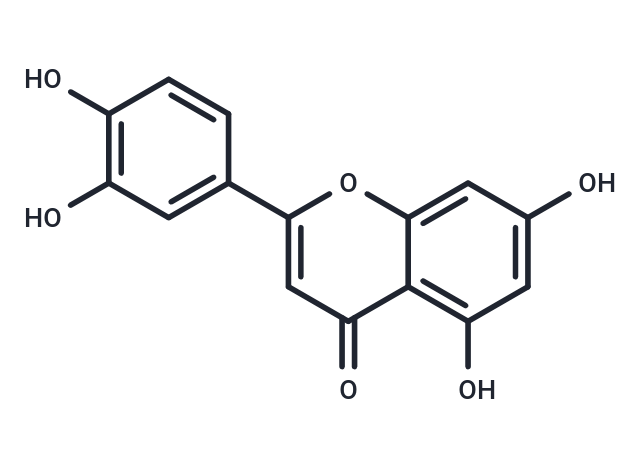Shopping Cart
- Remove All
 Your shopping cart is currently empty
Your shopping cart is currently empty

Luteolin (Luteolol) belongs to the flavonoid group of natural products and is a Nrf2 inhibitor, PDE inhibitor. Luteolin has a wide range of biological activities including antitumor, antioxidant, anti-inflammatory, antimicrobial, antiviral, antiallergic, and procoagulant.

| Pack Size | Price | Availability | Quantity |
|---|---|---|---|
| 10 mg | $39 | In Stock | |
| 50 mg | $45 | In Stock | |
| 100 mg | $55 | In Stock | |
| 200 mg | $86 | In Stock | |
| 500 mg | $148 | In Stock | |
| 1 g | $217 | In Stock | |
| 1 mL x 10 mM (in DMSO) | $43 | In Stock |
| Description | Luteolin (Luteolol) belongs to the flavonoid group of natural products and is a Nrf2 inhibitor, PDE inhibitor. Luteolin has a wide range of biological activities including antitumor, antioxidant, anti-inflammatory, antimicrobial, antiviral, antiallergic, and procoagulant. |
| Targets&IC50 | PDE5:9.5 μM(Ki), PDE2:6.4 μM(Ki), PDE1:15.0 μM(Ki), PDE4:11.1 μM(Ki), PDE3:13.9 μM(Ki) |
| In vitro | METHODS: ESCC cell lines EC1, EC9706, KYSE30 and KYSE450 were treated with Luteolin (10-80 µM) for 48-72 h. Cell viability was measured using the CCK-8 Assay. RESULTS: Luteolin inhibited the growth of ESCC cell lines in a dose-dependent manner with IC50 in the range of 20-60 µM. [1] METHODS: Human cervical cancer cells, HeLa, were treated with Luteolin (5-20 µM) for 48 h. Cell cycle profiles were analyzed using Flow Cytometry. RESULTS: Luteolin treatment blocked the cell cycle progression of HeLa cells in sub-G1 phase. [2] |
| In vivo | METHODS: To detect anti-tumor activity in vivo, Luteolin (50 mg/kg) was injected intraperitoneally once daily for eighteen days into BALB/C-nu mice bearing ESCC tumor EC1. RESULTS: The Luteolin treatment group showed a reduction in tumor size and a reduction in total tumor weight of about 65%. [1] METHODS: To study the effect on intestinal mucositis, Luteolin (3-30 mg/kg in water plus 1% Tween) was administered by gavage or intraperitoneally to irinotecan-induced intestinal mucositis in Swiss mice once a day for fourteen days. RESULTS: Luteolin prevented irinotecan-induced intestinal damage by reducing weight loss and diarrhea scores as well as attenuating duodenal and colonic shortening. [3] |
| Alias | Luteolol, Luteoline, Flacitran, Digitoflavone |
| Molecular Weight | 286.24 |
| Formula | C15H10O6 |
| Cas No. | 491-70-3 |
| Smiles | O=C1C=2C(OC(=C1)C3=CC(O)=C(O)C=C3)=CC(O)=CC2O |
| Relative Density. | 1.2981 g/cm3 (Estimated) |
| Storage | Powder: -20°C for 3 years | In solvent: -80°C for 1 year | Shipping with blue ice. |
| Solubility Information | H2O: < 1 mg/mL (insoluble or slightly soluble) 10% DMSO+40% PEG300+5% Tween 80+45% Saline: 5.7 mg/mL (19.91 mM), suspension.In vivo: Please add the solvents sequentially, clarifying the solution as much as possible before adding the next one. Dissolve by heating and/or sonication if necessary. Working solution is recommended to be prepared and used immediately. DMSO: 55 mg/mL (192.15 mM), Sonication is recommended. Ethanol: 3 mg/mL (10.48 mM), Heating is recommended. |
Solution Preparation Table | |

Copyright © 2015-2025 TargetMol Chemicals Inc. All Rights Reserved.